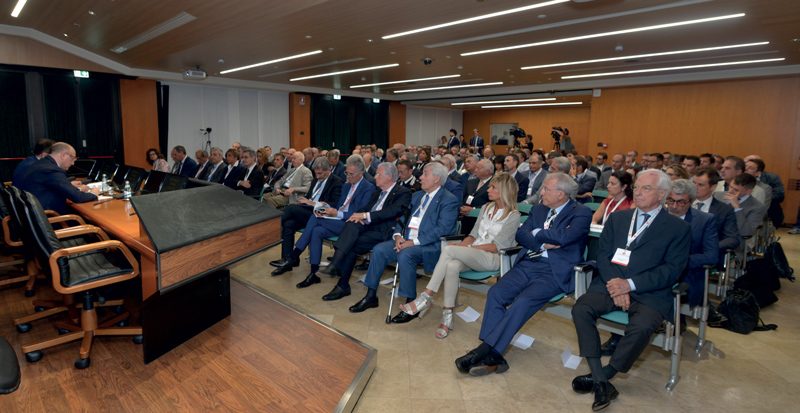Enterprise 4.0 and More: Investments Drive a Growing Sector
The trend of the machine tools, robots and automation sector is quite positive, with significant growth rates recorded in 2017 and encouraging forecasts according to the UCIMU Studies & Culture Department. This is partly (but not only) due to the confirmation of super- and hyper-depreciation, so far only used by less than half of the companies, as suggested by a research conducted by Eumetra.
by Sergio Soriano
The good news is that, in 2017, the Italian machine tools, robot and automation industry generated a turnover of over 9 billion euro, with the main economic indicators all rising. Even better news is that the forecasts for 2018 seem to confirm the growth trend, with Italy still in the fourth place among manufacturers, the third between the exporters and the fifth in the global ranking of consumption.
In detail, the forecasts for the current year show increased production and export. However, just like in 2017, consumption, deliveries to the domestic market and imports are expected to record the most significant increase, all double-digit, supported by super- and hyper-depreciation in compliance with the Enterprise 4.0 Plan.
“As for the domestic market, the order index for the second quarter of 2018, once again positive after the retreat of the first quarter, confirms the dynamism of the demand expressed by Italian users. The latter, considering the extension of tax incentives also for the whole year 2018, have resumed investing”, said last July Massimo Carboniero, president of UCIMU-Sistemi per produrre, during the annual shareholders’ meeting, also attended by the president of Confindustria, Vincenzo Boccia.
Data and trends for 2017 and forecasts for the current year
In 2017, production grew by 9.6% to 6,085 billion euro. A result determined both by the good performance of deliveries on the domestic market and by exports, which returned with a positive sign, reaching 3,385 million euro (+4.1%). Also the consumption had a double-digit increase for the third consecutive year, reaching 4.464 million euro (+15.7%). According to data from the UCIMU Studies & Culture Department, production will increase by 9.3% in 2018 to €6,650 million. Consumption will be €5,070 million (+13.6% over 2017), driving both manufacturers’ deliveries on domestic market and imports. Even exports will continue their growth, with a 4.6% increase.
In the second quarter of 2018, the machine tools orders index grew by 2.8% on an annual basis, once again positive (+0.5%) following the decline in the first quarter, evidently due to the uncertainty about the confirmation of super- and hyper-depreciation.
“The SMEs need time to evaluate and carry out investments – added Mr Carboniero – and this is even more true with Industry 4.0, implying actual organizational revolutions, which are quite difficult to imagine and implement”.
The research by Eumetra about the use of incentives
How the Italian companies are taking advantage of the government tax incentives addressed to machinery renewal? With the aim to give an answer to such a question, UCIMU-Sistemi per Produrre promoted a survey, carried out by Eumetra. On a sample of 200 companies in the metal-mechanical industry chosen with regard to their size, revenues, geographical area of and type of production, 90% of the persons interviewed, prominent figures in companies (owners, managing directors, general managers) know about the provisions for the renewal of machinery and the digital transformation of the factory. The 10% who know nothing about it are definitely out of step.
This having been said, only 46% state they used the incentives. The most dynamic sector is the automotive industry, with the greatest number of machinery purchases. A primary role is played by the larger companies. In terms of geographical macro-areas, the North-West, followed by the North-East, made the greatest use of the super- and hyper-depreciation incentives. Among the objectives which drove the renovation of the machine park, the desire to increase production capacity stands out, while the fiscal benefits were considered last.
Favouring knowledge to avoid the digital divide
A positive signal is given by 51% of companies who declare they intend investing between 2018 and 2019, along with 75% aware of the changes required after the request for hyper-depreciation (with the training of personnel taking first place). Basically, there are two general considerations which emerge from this survey. The first is that over half of the companies were not touched by the current “revolution”, that is, they did not invest at all in 2017 in new production technologies, be they purchased/ordered following the super- or hyper-depreciation provisions.
The second consideration concerns the growing gap in the manufacturing system between innovative enterprises aspiring to improve and companies anchored to the past. Those who made, or will make, investments during these two years aim at machines equipped with digital technologies. Conversely, a sizeable part of those who did not invest yet do not intend doing so in the future either. The combination of these two opposite approaches will lead to potentially dangerous effects, broadening the digital divide among companies, with a few which will become even stronger and many more destined to drop out of the market. It is not just a matter of fiscal incentives, but an actual way of organizing an activity so as to be competitive nationally and internationally.

